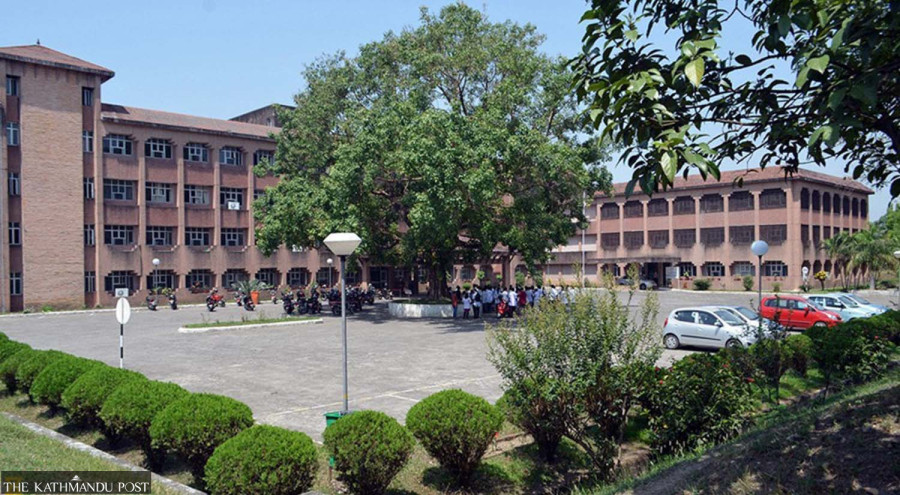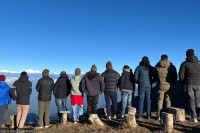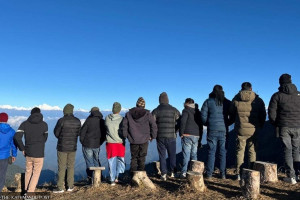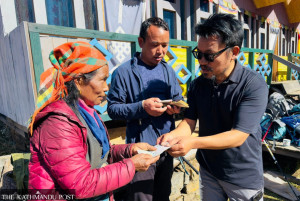Koshi Province
Dharan sub-metropolis hit by severe water shortage amid continued heat wave
The BP Koirala Institute of Health Sciences postpones its classes for a week due to the crisis.
Arjun Poudel & Arjun Subedi
On Tuesday, the Dharan-based BP Koirala Institute of Health Sciences postponed all classes for a week because of a severe water crisis. The institute does not have an adequate water supply for the hospital and its college buildings.
“There is an acute shortage of water in the hospital, and college and hostel buildings. The medical science students have been given a weeklong break so that the daily hospital services won’t be affected much,” said Prof Dr Sanjib Sharma, acting vice-chancellor at the BPKIHS.
He said the decision to postpone classes will not affect the curriculum. According to Sharma, the students also requested the institute in writing to close classes for a few days.
According to the BPKIHS, the hospital alone needs around 1.5 million litres of water daily. The institute said the drinking water management board of the sub-metropolis has been supplying just 500,000 litres of water daily, although the agreement is to supply 1.5 million litres.
Mayor Harka Sampang, who is also the chairman of the board, dismissed the institute’s claims of reduced supply. Sampang claimed that the board supplied 2.1 million litres of water to BPKIHS on Tuesday “but the institute is hell-bent on defaming the sub-metropolis.”
It isn’t only the BPKIHS that has been affected by the water crisis. Residents of the sub-metropolis have said water shortage has severely affected their daily lives. The scarcity, coupled with scorching heat and heat waves, has made Dharan locals miserable, says Shyama Regmi, 65, a local of Ward 1.
A severe heat wave that has hit several places in the Tarai region since Friday has triggered a water crisis in many places, including Dharan.
“It is too hot here in Dharan and we do not have water,” said Regmi. “We get water from the public tap once in four days and that too only for a few minutes, which is not even sufficient for drinking.”
With the rising mercury and heat waves, health authorities have urged people to stay hydrated, take baths regularly and stay indoors. But the locals question the logic behind the request since they do not have water to take a bath even once a day.
“We have a serious water crisis in our area,” Rita Sundas, municipality council member from the sub-metropolis’s ward 1, told the Post.
Officials at the sub-metropolis held a meeting of stakeholders on Tuesday and discussed the worsening water crisis.
“Today [Tuesday], we held a discussion about the water crisis in our area and have decided to better manage the water distribution,” said Yagya Mani Acharya, chair of ward 1 of the sub-metropolis.
Daytime temperatures in several Tarai districts have been hovering around 40 degrees Celsius in recent days. The Meteorological Forecasting Division of the Department of Hydrology and Meteorology said that many places in the region have been witnessing heat waves since Friday.
A heat wave occurs when the maximum and minimum temperatures at a location are unusually high over a three-day period. Met officials said that there is a chance of rainfall in the western and midwestern regions which could break heatwave conditions.
According to the latest weather update, on Wednesday, Simara of Bara and Janakpur recorded 41.7 degrees Celsius and 42.2 degrees Celsius, respectively; Bhairahawa logged 41.8 and Nepalgunj 41.6 degrees Celsius, respectively. Likewise, Biratnagar recorded 41.0 and Dharan recorded 39.3 degrees Celsius, respectively.
Birendranagar recorded 38.9 degrees Celsius, according to the Met division. The maximum temperature in Kathmandu during the day was 32.1 degrees Celsius.
The Met Office said that the monsoon is likely to be delayed by a few days this year.
The monsoon season in Nepal generally starts on June 13 and ends on September 23. Last year, however, it entered the country eight days ahead of schedule.
Normally, after the arrival of monsoon, it takes one week for the clouds to spread across the country.
Globally, extreme weather events are increasing in frequency, duration and magnitude. Scientists blame climate change for the early onset of summer and intense heat.
The average annual maximum temperature of Nepal rose by 0.056 degrees Celsius between 1971 and 2014, according to a study conducted in 2017 by the Department of Hydrology and Meteorology (DOHM).
Meteorologists have forecast below-average rainfall in the upcoming monsoon season. The department’s climate section, which forecast weather conditions for four months (June 1 to September 30), said that most parts of the country are likely to experience an above-average maximum temperature due to the El Nino conditions, a climatic pattern that generally brings dry weather.
Nepal is one of the world’s most vulnerable countries to the climate crisis and has witnessed frequent extreme weather events over the past decade and a half.




 13.12°C Kathmandu
13.12°C Kathmandu
















